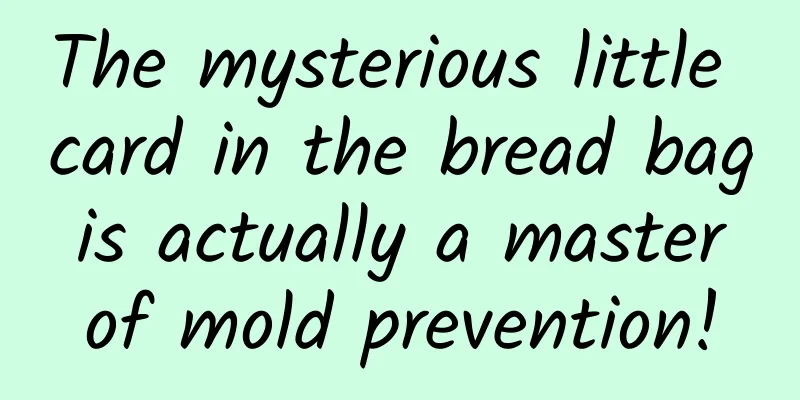The mysterious little card in the bread bag is actually a master of mold prevention!

|
Have you ever wondered why there is always a small card in the packaging of bread and cakes? Image source: 1688.com To understand the purpose of these little cards, we first have to understand why food goes bad. 01 The Secret of Food Spoilage The process of food spoilage is a battle of biological, chemical and physical factors, and the outcome is bound to be a major defeat of color, aroma, taste and nutritional value. Microorganisms are the "troublemakers" among them. They will grow and multiply rapidly under the right temperature, humidity and nutrients, decompose proteins and fats, and release unpleasant odors and potentially deadly toxins . The most typical one is Aspergillus flavus, which can produce aflatoxin and has been listed as a Class I carcinogen by the World Health Organization (WHO). The toxicity of aflatoxin B1 is 10 times higher than that of potassium cyanide and 68 times higher than that of arsenic. See gray-green mold on your bread? Throw it away, don't take risks! Image source: 360doc.com Oxidation is also the "black hand" behind spoilage. The fat and protein in food will produce odor and color changes during oxidation, which not only affects the appearance and taste of the food, but may also reduce its nutritional value. For example, myoglobin in meat products will form brown substances after oxidation, causing the meat to fade and the quality to decline; cooking oil will also become rancid due to oxidation after being stored for a long time, emitting an unpleasant smell. Image source: laishu.com Therefore, controlling these biological, chemical or physical factors is the key to extending the shelf life of food. Through proper processing, packaging and storage methods, the occurrence of these adverse changes can be effectively slowed down. 02 The function of the mysterious little card Those little cards hidden inside packaging are food preservation cards, usually made of absorbent paper or cloth impregnated with antibacterial ingredients such as alcohol. The application effect of alcohol gas in food preservation shows that alcohol (ethanol) has antibacterial ability and can effectively inhibit the growth of bacteria and mold at low concentrations, thus extending the shelf life of food. The alcohol content in food preservation cards and its concentration in the air are key factors. In baked foods, when the alcohol gas concentration reaches 7000-8000ppm, the anti-mold effect on cakes is very significant; when it reaches 8500-9500ppm, the anti-mold effect on bread is significant; when it reaches 6000-7000ppm, the anti-mold effect on moon cakes is significant. Image source: sohu.com So, can people who are sensitive to alcohol eat bread packaged in this way? Alcohol is in gaseous form in the packaging bag, and most of it evaporates after the bag is opened, with a concentration of about 0.7% to 3%. It is fine for normal people to consume, but it may have some adverse effects on people who are allergic to alcohol or have weak gastrointestinal function. 03 Common methods of food preservation In addition to using food preservation cards, what other common preservation methods are there? -Refrigeration and freezing Refrigeration is the process of placing food in an environment of 4-8°C to slow down the effects of bacteria. It is mainly used for short-term storage of fruits, vegetables, cooked food, etc. Freezing is the process of storing food at a temperature of -18°C or lower to freeze the liquid water in the food into a solid state. It can effectively inhibit bacterial activity and is suitable for long-term storage of quick-frozen foods such as fish and meat. Compared with freezing, refrigeration still has the risk of bacterial growth due to its higher temperature, so it needs to be cleaned and disinfected regularly. Image source: suning.com Deoxygenation preservation technology Cut off the oxygen supply of bacteria or mold to prevent their growth, thereby preventing food from oxidizing and spoiling. You can use vacuum packaging to isolate oxygen, or add deoxygenating preservatives such as iron powder or ferrous salts, which will react with oxygen in the air and consume all the oxygen. Image source: hbgreen.com Controlled atmosphere preservation technology Modified atmosphere preservation is also known as modified atmosphere freshness locking. It is similar to the method of isolating oxygen. By changing the gas composition in the package (such as the ratio of oxygen, carbon dioxide and nitrogen, etc.), an environment that is not conducive to the growth of microorganisms is created. Carbon dioxide is a key gas in modified atmosphere packaging. When its ratio exceeds 30%, it has a significant antibacterial effect. Modified atmosphere packaging technology can be widely used to preserve various foods, including meat, fruits, vegetables, etc. Image source: rodbol.com Microbial preservation technology Utilize the strategy of "controlling bacteria with bacteria" - use natural or modified beneficial microorganisms (such as lactic acid bacteria) to inhibit the growth of harmful microorganisms. Lactic acid bacteria can compete for nutrients on the one hand, and produce antibacterial substances such as lactic acid or antimicrobial peptides on the other hand. In this way, the fate of harmful microorganisms is to be killed by acid, starvation or poisoning, thereby achieving the effect of food preservation. Of course, the antibacterial substances can be extracted or synthesized for direct use. For example, specific lactic acid bacteria can produce an antibacterial peptide called Nisin, which has a strong antibacterial effect, especially effective against Gram-positive bacteria (such as Staphylococcus aureus and Listeria). At the same time, Nisin is recognized as a safe and edible food additive and is widely used in foods and beverages such as dairy products, meat products, and canned foods. Image source: po.baidu.com The above preservation methods are not isolated. In many cases, two or more methods are used in combination. For example, meat that is kept fresh in a controlled atmosphere also needs to be refrigerated. What other fresh and interesting preservation methods do you know? Please leave a message in the comment area to share. References [1] Wang Zhiqiang, Yang Fuxin. Effect of antibacterial paper on the preservation of toast [J]. Journal of Food and Biotechnology, 2020, 39(12): 57-61. [2] Lin Canhuang. Research and development status of deoxidation packaging principle and deoxidizer [J]. Food Information and Technology, 2004 (11): 51-51. [3] Huang Li, Kong Baohua, Li Jing, et al. Mechanism and influencing factors of quality deterioration of meat and meat products caused by oxidation[J]. Food Science, 2011, 32(9): 319-323. [4] Lü Feng, Lin Yongyi, Song Lijun, et al. Research on ice temperature controlled atmosphere preservation technology for beef[J]. Jiangxi Food Industry, 2008 (4): 15-18. [5] Huang Junyan, Han Chunyang, Jiang Hao. Application of modified atmosphere fresh-keeping packaging technology[J]. Packaging Engineering, 2007, 28(1): 44-48. [6] Liu Lin, Zhang Dequan, He Zhifei. Research progress on preservation technology of processed meat products[J]. Meat Research, 2008, 22(5): 3-9. [7] Hu Xiaoliang, Zhou Guoyan. Application of new preservation technology in food storage and preservation[J]. Food Research and Development, 2010, 31(12): 242-246. [8] Zhang Yan. Application of physical technology in food storage and preservation[J]. China Food, 2018 (8): 148-149. [9] Wang Yu, Wu Can. Application of natural preservative - Nisin in food industry[J]. Chinese Condiment, 2009, 34(6): 100-102. [10] Wang Jiayu, Hu Wenzhong, Guan Yuge, et al. Research progress on the antibacterial mechanism of nisin and its application in food preservation[J]. Science and Technology of Food Industry, 2021, 42(3): 346-350. [11] Ghidelli C, Pérez-Gago M B. Recent advances in modified atmosphere packaging and edible coatings to maintain quality of fresh-cut fruits and vegetables[J]. Critical Reviews in Food Science and Nutrition, 2018, 58(4): 662-679. [12] Iversen LJL, Rovina K, Vonnie JM, et al. The emergence of edible and food-application coatings for food packaging: a review[J]. Molecules, 2022, 27(17): 5604. Author: Ji Minghua, PhD, Shanghai Advanced Research Institute, Chinese Academy of Sciences Planning & Editing: rain, HYJ |
<<: Can a mobile phone be worn on the wrist like a watch?
>>: #千万IP创科普# During the National Day holiday, please keep this highway driving safety guide
Recommend
Alternative ideas for hot updating of Node.js Web application code
[[135563]] background I believe that students who...
Summary of essential tools for new media operations and promotion! (superior)
If you want to do your work well, you must first ...
How to keep the oil flowing? Build a "highway" for the oil to flow!
"Shale is very dense, and oil cannot be extr...
Four steps of community operation: Taking the operation of King of Glory group as an example
When operating a community , the following steps ...
This silly big dog has saved more than 4,000 people
December 24 was a sleepless night for the North A...
The flames emitted by rockets are over 3000℃, how come they don't burn themselves? They have ways to cool down
Relying on the high-temperature flame ejected fro...
This isn't a crushed Oreo, it's a fish
Perhaps in the eyes of many people, fish all look...
The “New World” of Mobile Applications Going Global
The story of Columbus's discovery of the New ...
More than 50% of the review rejections are due to these 10 reasons (Attached with the latest AppStore review guidelines for 2016)
Recently, Apple listed the top ten reasons for ap...
Sharing of Douyin's highly profitable money-making project: Douyin snack training monetization project, with profits exceeding a thousand for one order!
The project that I will be dissecting for you tod...
The gorgeous fireworks you see are actually "electrons" dancing
During festivals or grand events, fireworks are o...
Estimated time for Changchun City to be unsealed in 2022: When will it be fully unsealed? Attached are the conditions for lifting the lockdown!
According to the latest report, from 0:00 to 24:00...
After 2 years at Tencent, I have benefited a lot from these 15 operational experiences!
What kind of preparation and capabilities are nee...
Apple releases the official version of iOS 12.4: brings multiple new features!
In addition to launching iOS 9.3.6 and iOS 10.3.4...









